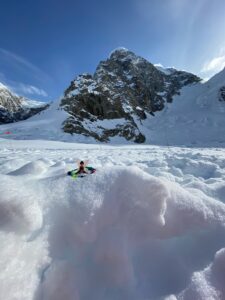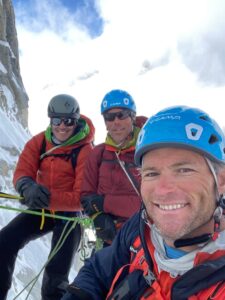"Alaska favors the strong."
Uphill Athlete coach Jason Antin kept reminding me of this in the months leading up to our spring climbing trip to the Alaska Range. “You’ll be out there for twelve, fourteen, sixteen hours straight, trying to optimize a weather window,” he told me, “then you’re going to get into camp, and you’re going to need to have energy to build camp, build a platform, chop a ledge, put a tent up, get water going, feed yourself—and then sleep for six hours and go do it all again the next day.” Jason knew this from his own trips, and he knew exactly how to get me to where I needed to be. I just needed to follow the plan.
Growing up I always had some exposure to the mountains. In the winter I downhill skied, and every summer we’d do a backpacking trip or two as a family and go climb something in the Sierra—a 14er or a 13er, nothing too crazy. In general I spent much more time in the pool than in the mountains, swimming and playing water polo. Then about five years ago, my wife and I moved to Colorado (she’s originally from Denver). After being here for about a year, I was kind of kicking myself: there we were, living in Colorado, and I wasn’t taking advantage of the mountains right in our backyard.
I started doing more hiking and some casual 14ers, which led me to the Colorado Mountain School for outdoor education. I began working with a couple of their guides, mostly up in the Rocky Mountain National Park area, learning all the disciplines—alpine climbing, rock climbing, ice climbing, backcountry skiing—basically throwing myself into the fire. At the time, training specifically for climbing and mountaineering wasn’t front of mind; I was already in good physical shape from doing about three marathons a year in my quest to qualify for the Boston Marathon. After missing the cut by 90 seconds in 2018, despite putting in a maximal effort, I decided to double down on climbing. Marathon running felt very one-dimensional, not nearly as engaging as moving efficiently through the mountains and over technical terrain. I started booking bigger trips and setting my sights on bigger objectives.
It was a fall trip to a 6,000-meter peak in Nepal in 2019 that inspired me to revisit the physical training piece. I had designed my own training plan, and I did OK on the fairly technical peak, but I sensed I could have arrived better prepared. So instead of continuing to wing it for my next trip—I hoped to tackle something more technical in Alaska, possibly the Cassin Ridge—I reached out to Uphill Athlete for one-on-one coaching in 2021. It was time to put a little more science behind the program. They hooked me up with Jason, who also lives in Colorado, also has two young kids, and had summited Denali twice (once by the Cassin) in a single week. As a bonus, he’s a Colorado Mountain School guide, and we quickly discovered we had some mutual friends.

At some point during the training, Jason and I decided we would go to Alaska together, along with another CMS guide I had been climbing with a lot over the past couple of years, Joey Thompson. We were all beating to the same drum and figured it would be a good way to test our teamwork for bigger objectives. Early on we decided the Cassin would be too much for my first trip to Alaska. Instead, Jason and Joey came up with a tick list of a half dozen climbs that mimic the Cassin and would be a good dry run, both from a technical perspective and in terms of grade and commitment. We eventually settled on Peak 11,300, an Alaska Grade 5 route that is considered to be a testpiece for the Cassin. It features a lot of similar climbing: nothing is extremely technical, but it’s long, pitch after pitch of moving over varied terrain, which is the kind of climbing I like to do. The plan for the 10-day trip was to fly into the West Fork of the Ruth Glacier and go after Peak 11,300, then possibly do something else, maybe Ham and Eggs over on the Root Canal Glacier or one of the climbs near Denali Basecamp.
The training itself was very well balanced, and it felt like everything had a purpose. There was a lot of focus on ice axe hangs and building upper-body strength for the technical climbing portions, but the overall thrust was endurance, just spending a lot of time on my feet, time in the mountains. The goal was to develop a reserve I could always draw from.
That came into play on Peak 11,300: I had a reserve. It was a day of really good weather, though the winds were intense. We pushed through the first half of the climb, tackling some of the most technical sections on the route. For me it was some of the hardest climbing I’d ever done, and doing it with a 50-pound pack was a new level for me. But I popped out of the crux and still had energy. Fourteen hours in, I was a little tired, but I wasn’t physically breaking down. I could have kept going.

The weather had other ideas. The team decided that there wasn’t enough margin for error in the strong system we thought would be coming through, so we bailed. We spent another whole day rappelling off the route, which I learned is the hardest thing on some of those mountains—not climbing them but getting off of them. The next day it turned out the weather was probably good enough for us to have summited and gotten back down, but we just didn’t know and didn’t want to take the risk.

From there, we flew over to Denali Basecamp. Moving camp and lugging gear around was tougher than I’d anticipated. Sure, we weren’t humping loads up to 14,000-foot camp, but it was a surprise to me how much energy it took to break camp, put it on sleds, drag it to the airstrip, put it all on the plane, fly for 45 minutes, take it all out of the plane, drag it to the new camp, and then dig platforms, set up the tents, get meals going, boil water—all the basic tasks. I’d assumed that I would be putting out my maximum effort while hiking uphill or swinging my ice tools, but some of the tax on your body on these trips comes in the “off” moments that you don’t expect. That’s where the Zone 2 mentality of being able to move consistently all day long at a sustainable, healthy pace becomes essential. Operating in that mode, I was able to get through the bump over to Denali without getting totally knackered. Still, it caught me off-guard.
Once we set up camp, it was great to be at Denali Basecamp in early season. It wasn’t super crowded like I’ve heard it can get, and I got to meet some really cool people—great climbers who were there working on projects. It’s a quintessential Alaskan zone, framed by Mount Hunter, Mount Foraker, and the peaks of Denali. From there, we skied up the glacier to the Mini-Moonflower on Hunter and got through about a third of it—10 pitches of WI3 to WI4—before I burned out my calves. That was the one area that Jason and I decided was my weakness: my calves. I got pretty smoked out at the hanging belays on the near-vertical to vertical ice. Still, it was a fun climb and a fun ski back down the glacier to camp.

We had a huge system coming in the next day or two, so again we made the decision to bail. Although it was a bummer to leave, the trip had given me the perfect first taste of the Alaska Range—the environment, the grades, and the style of climbing. And I’ll be honest: I felt amazing, just so strong. Except for my calves on the Mini-Moonflower, I never felt like I was in over my head. I probably could have climbed something bigger or done even more. That gave me a lot of confidence, both on the climbs and coming out of the trip. I saw that the training formula worked. Possibly the hardest physical part of the whole thing was the red-eye from Anchorage back to Denver. The jet lag just crushed me.
Mentally, I struggled with not topping out. I’m a summit guy: I like to have a clearly defined goal, execute it, and move on. So bailing—especially from Peak 11,300—was a challenge. At the same time, it was deeply rewarding to still feel fresh after a day of climbing a really tough route. I had to realign my mindset, because all things considered, the fact that I was able to do what I did and be where I was at physically was a big payoff.
Plus, the teamwork was excellent. I’d already climbed a lot with Joey, so I knew we worked well together. And my and Jason’s personalities also meshed really well. The guy’s a go-getter, just a total animal. He led every single pitch on 11,300 and was always positive, which was a huge help on that route. We got beers and pizza in Anchorage afterward and we’re all still friends. I’ve already been chatting a bit with Jason about what might make sense for next year, now that I know what Alaska has to offer. It’s far easier to get to Anchorage from Denver than to Nepal or South America—very helpful when you have kids.
I’m not going to lie, there are days when the training schedule is a bit daunting—anywhere from 10 to 15 hours a week when we’re peaking, split between time outside and indoor strength. But I’ve seen the benefits now. To do an objective safely and effectively and have a good shot at it, you need to stick to the plan, and the plan works. Coming off my self-taught marathon training program of Zone 3/4+ running for so long, it was an experiment for me: Does this Zone 2 philosophy work? It certainly did on our Alaska trip, and I’m planning to stick with it for the next big thing.

